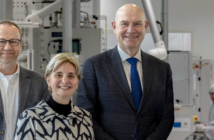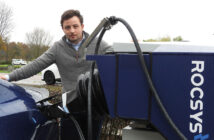 General Motors Co. en Honda hebben een joint venture getekend om hydrogen fuel cell systemen voor de toekomstige modellen te gaan produceren in Michigan.
General Motors Co. en Honda hebben een joint venture getekend om hydrogen fuel cell systemen voor de toekomstige modellen te gaan produceren in Michigan.
“Over the past three years, engineers from Honda and GM have been working as one team with each company providing know-how from its unique expertise to create a compact and low-cost next-generation fuel cell system,” said Toshiaki Mikoshiba, chief operating officer of the North American Region for Honda Motor Co. and president & CEO of American Honda Co. Inc. and Honda North America, Inc. “This foundation of outstanding teamwork will now take us to the stage of joint mass production of a fuel cell system that will help each company create new value for our customers in fuel cell vehicles of the future.”
The Fuel Cell System Manufacturing (FCSM) joint venture will be operated by a board of directors consisting of three executives from each company that will include a rotating chairperson. In addition, a president will be appointed to rotate between each company.
GM and Honda have more than 2,220 fuel cell technology patents between them, according to the Clean Energy Patent Growth Index. GM and Honda rank No. 1 and No. 3, respectively, in total fuel cell patents filed in 2002 through 2015.
“The combination of two leaders in fuel cell innovation is an exciting development in bringing fuel cells closer to the mainstream of propulsion applications,” said Mark Reuss, GM executive vice president of global product development, purchasing and supply chain. “The eventual deployment of this technology in passenger vehicles will create more differentiated and environmentally friendly transportation options for consumers.”
Fuel cell technology addresses many of the major challenges facing automobiles today: petroleum dependency, emissions, efficiency, range and refueling times. Fuel cell vehicles can operate on hydrogen made from renewable sources such as wind and biomass. Water vapor is the only emission from fuel cell vehicles.
In addition to advancing the performance of the fuel cell system, GM and Honda are working together to reduce the cost of development and manufacturing through economies of scale and common sourcing. The two companies also continue to work with governments and other stakeholders to further advance the refueling infrastructure that is critical for the long-term viability and consumer acceptance of fuel cell vehicles.
GM is currently demonstrating the capability of fuel cells across a range of land, sea and air applications. The company has accumulated millions of miles of real-world driving in fuel cell vehicles.
“With the next-generation fuel cell system, GM and Honda are making a dramatic step toward lower cost, higher-volume fuel cell systems. Precious metals have been reduced dramatically and a fully cross-functional team is developing advanced manufacturing processes simultaneously with advances in the design,” said Charlie Freese, GM executive director of Global Fuel Cell Business. “The result is a lower-cost system that is a fraction of the size and mass.”
Honda began delivery of its all-new Clarity Fuel Cell vehicle to U.S. customers in December 2016 following a spring 2016 launch in Japan. The Clarity Fuel Cell received the best driving range rating from the EPA of any electric vehicle without a combustion engine with a range rating of 366 miles and fuel economy rating of 68 miles per gallon of gasoline-equivalent combined.




